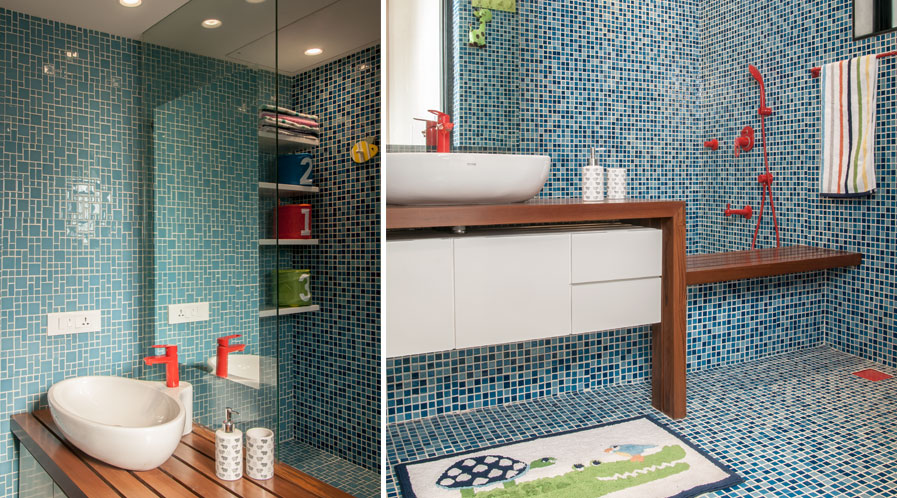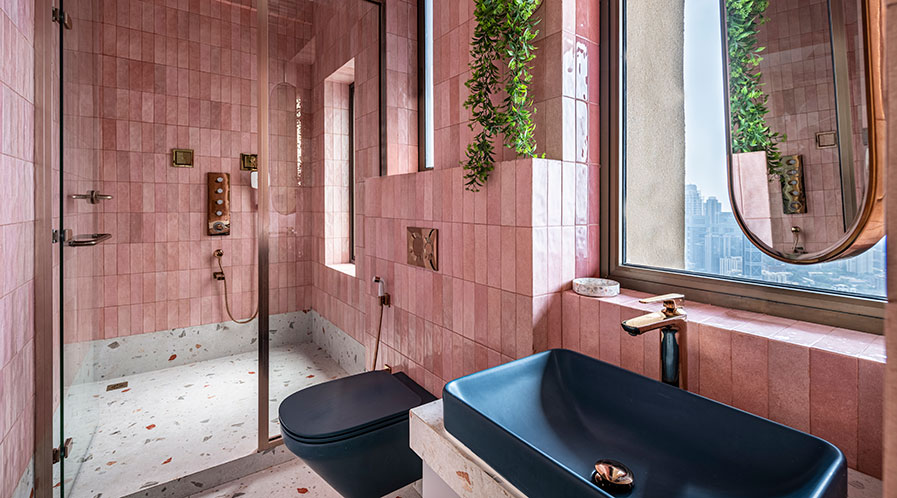Child's Play
A well-designed kid’s washroom is all about providing a fun-filled space, which can even be exploratory in nature, with a cheerful vibe while also ensuring hygiene and safety, writes Sanjitha Suresh.
The washroom space has evolved over time to suit the personal requirements of the users. So much so that the user’s personality is said to be reflected in the design of the space. Conforming to that trend, kid’s washroom has gained a lot of attention.
The segment has become quite attractive for the manufacturers of bath products too and the kids are now deemed to be a key influencer in the buying process. We have seen a massive influx of kid-centric collections in paints, surfaces, fixtures, wallpaper and accessories. This has given the designers plenty of choices in materials and fixtures to work with.

Swanzal Kak Kapoor
Principal Designer, Saka Studio
“While working on a theme, we are careful to select a mood board of tiles that has a timeless quality and can transition from toddler to young adult seamlessly.”
Design aspects of a kid's washroom
One generalised standard that is followed in every washroom is the segregation of wet and dry areas. The layout is planned to keep all activities of the wet areas separate from the activities of the dry areas. The same holds for a washroom designed for kids as well.
But, that is where perhaps the similarity ends! A kid’s washroom is specially designed in order to cater to their anthropometry. “Designing a kid’s bathroom is quite different from designing an adult’s bathroom. A fun element must be incorporated – be it an addition of colour or some playful print in the tiles you choose,” asserts Mitali Aharam, Managing Partner, Crafted Spaces.
She further adds, “The height factor and ease of access should be taken into consideration. If you are planning for a growing child use an accessible stool so the sink faucets are not out of reach. The bathroom should be designed in a way that towels, soaps, shampoos, napkins, toothpaste and toothbrush are within the child’s reach.”
Anjali Lovekar, Principal Partner, Lovekar Design Associates feels that the difference between designing an adult and a kid’s bathroom is essentially about the experience. For most part of the time spent by an adult in the toilet, functional efficiency and a quiet ambience in a bathroom work better than a fancy one. “Kids, on the other hand, are learning from their surroundings by observing subconsciously everything they see or do. The happiness is more about reaching out to the toothbrush on the counter on their own without a prop, or creating bubbles in a bucket or squatting on the floor and soaking in the flowing property of the water unknowingly.”

When it comes to bath spaces, it is essential to keep comfort as a prerequisite while designing a bathroom. “For a kid’s bathroom, it is imperative to understand their needs and comfort in terms of ergonomics, safety, and accessibility. The key differentiator between an adult’s and a kid’s bath space is ergonomics. Toilets and sinks should be installed according to the kids’ height for ease of use,” opines Manish Dikshit, Partner, Aum Architects.
Summing up the design requisites of a kid’s washroom, Swanzal Kak Kapoor, Principal Designer, Saka Studio shares, “Our approach when designing a child’s bathroom is to look at a certain playfulness in scale and material palette that allows for an imaginative and inspiring space. The key factor is to plan for additional storage that is appropriate for a child’s needs, ensure anti-skid finishes on the floor and design counters that are height-sensitive.”
According to Lovekar, the design approach will vary depending upon the age of the child. “For small children, the bathroom is a fun activity where they feel the water, understand the concept of hot and cold, and generally enjoy getting wet and splashing. For older kids, it can be a routine and time-bound activity through the week centred around school and other timings. For young adults, it can be a place akin to a beauty and spa regime with longer time spent in the bathroom.”

Anjali Lovekar
Principal Partner, Lovekar Design Associates
“Kids, on the other hand, are learning from their surroundings by observing subconsciously everything they see or do.”
Selecting Materials
Fixtures, fittings, and vanities used in the washroom can be provided with different colours to make the space look bright. Accessories like mirrors, soap dispensers, litterbox, and brush stand should have interesting designs that can easily catch the attention of a kid.
One can even dedicate a particular space on a higher level just for bath toys used as décor. Soft accessories like towels, curtains, and carpets can also be selected according to the theme of the entire washroom space and given a colourful touch. The future of bathroom technology includes 3D flooring, which is an excellent option to follow a particular theme and incorporate it in a kid’s washroom.
“Incorporating a bathtub is a great idea in a kid’s bathroom. It can be small and shallow depending on the child’s age so they can play with their toys comfortably. Young or old, you can never have enough bathroom storage! Once a child feels connected to the space, it will be easier for the parents to teach them good bathroom etiquette as well,” says Aharam.

Since one cannot change a bathroom every three years to suit the age group, one has to keep a flexible design in mind. “We, at LDA, have a mature approach towards the bathrooms so the appeal lasts longer. In terms of functionality, all age groups require parameters like blended and softened edges for counters, softened edges for level drop difference, correct drainage slope, switchboards at the correct height, auto-on light on opening the door, power points at adult use height, mixers with set temperature thermostat, easy function faucets and sanitary fittings, sufficient lighting, and good ventilation,” shares Lovekar
She further adds, “For young kids, temporary accessories like tubs, wall stickers, moulded bath, potty seats, and climber steps to reach basin bowl can be added to retain the wall finishes as they grow out of assisted bathroom activities. All these accessories can be done away with ease later.”
A kid’s washroom should be provided with materials that can sustain wear and tear, are durable and have high resistance. All materials used on walls, floors, vanities and other fixtures must be able to facilitate cleaning and water conservation wherein, a minimum amount of cleaning agents and water is used. “Using durable materials that don’t stain easily, easy to use hardware, soft closing shutters and drawers are some factors to be kept in mind,” opines Aharam.

Mitali Aharam
Managing Partner, Crafted Spaces
“Designing a kid’s bathroom is quite different from designing an adult’s bathroom. A fun element must be incorporated – be it an addition of colour or some playful print in the tiles you choose.”
Making it playful
The ambience of a kid’s washroom must evoke interest and excitement within the user. In order to create an inviting environment, specific colours and themes should be used in the space that can have a huge impact on the mood of the user. It must be a cheerful and colourful space that brings in a lot of fun in terms of theme and accessories.
For starters, the entire washroom space can be given a unique look just by selecting a specific theme like coastal, forest, fairy-tale, aquatic, adventure, floral, and so on. Themes can be made more appealing by using different coloured mosaic tiles and wallpapers.
“While working on a theme, we are careful to select a mood board of tiles that has a timeless quality and can transition from toddler to young adult seamlessly. A sensitive eye for colour and texture ensures freshness and vibrancy. We tend to juxtapose three materials/colours within the bathroom interior to add a colour play,” says Kapoor.

She further adds, “We like to keep the colour palette and finishes timeless enough that a child will not grow out of the space; so, overtly ‘child-like’ patterns and colours are avoided. Keeping the overall style simple yet joyous is a priority.”
It’s always recommended to use vibrant tile choices so that the few moments in bathrooms can be fun-filled ones! “Subtle shades in pastel work in sync with capturing natural light, creating an easy ambience in the bath spaces,” opines Dikshit.
Aharam agrees, “Experiment with colours if you don’t want to do a conventional bathroom for a young kid or teen. Even darker colours can be made to look interesting with some mix of patterns. Colours can really bring out your kid’s personality which can be amplified with good lighting.”
A bold and solid colour palette sets the kid’s bathroom apart from an adult’s bathroom. Also, it works through a wider age spectrum from kids to young adults. “Solid colours are also a way to communicate with kids as part of teaching them colours. Numeric stickers can teach them to count and alphabet stickers can teach them spelling. Once again, such props are easy to dispose of and make way for the growing age while keeping the finishes the same,” shares Lovekar.

Manish Dikshit
Partner, Aum Architects
“The key differentiator between an adult’s and a kid’s bath space is ergonomics. Toilets and sinks should be installed according to the kids’ height for ease of use.”
Ensuring safety
Safety is paramount when designing a kid’s bathroom. It is essential to incorporate non-slip floorings and proper slopes and drains so that no water is accumulated in the corners. Tiling the walls is necessary so that fingerprints and dirt are easy to clean. Handrails can be provided beside toilets for easy access and grips making the bath space comfortable.
“Safety is above all. You have to be very careful about the safety of the children because they might slip in the tub or on the floor. The most important things is to make sure to use tiles for the floor that are anti-skid to prevent slips and falls,” opines Aharam.
She further adds, “Sharp edges may hurt them; so make sure that everything placed in the bathroom has round edges. You can use tub mats or sticky pads on the bottom of the bathtub because these won’t let your kid slip in the water. A nightlight is always a good idea in a kid’s bathroom. Integrated sinks are easier to maintain since they avoid too many corners and grooves. Larger tiles that are easier to clean with not too many grout areas should be used. Never keep harmful chemicals or toiletries within his reach, giving him a chance to play with them.”
The design layout for kids’ bathrooms should offer maximum circulation in terms of movement, light, and ventilation. “Young children tend to be messy; so, it’s better to install wall-mounted fixtures so that floors are easy to clean and maintain. Faucets with colour coding such as red and blue indicators for hot and cold water respectively should be used; installing drawers below sinks may be a preferable choice for easy access to the kids,” states Dikshit.
Hygiene and safety come from maintaining a dry bathroom and containing the bathing activity in a well-drained zone. The finishes should be wiped clean so that they dry easily. The bathroom has to be well-lit and well-ventilated in either a natural or forced manner. Kids are not into mood lighting.
“We recommend bathroom surfaces that can be wiped clean with plain water since kids have no qualms about touching and feeling everything they can. Of course, slippery finishes are dangerous. Surfaces are cosmetic finishes. A good bathroom should have correct slopes for quick drainage and sound plumbing to avoid leakages. Sharp, metallic or glass objects should not be placed in a kid’s bathroom,” conveys Lovekar.

Making sure a child doesn't outgrow the space
From toddlers to young kids to young adults, kids grow fast and often tend to outgrow their tastes and preferences. It is important to tackle this and make sure the bathroom can be used for a relatively long term without a major overhaul.
“While designing, an important factor to keep in mind is to create a timeless bathroom that will grow with them by using accents that can easily be updated, like paint, mirrors, and accessories. Another great idea to get colour into the bathroom is simply painting the cabinets in a stand-out hue for added personality. This is easier too as you can just change the cabinet colour as the child grows instead of remodelling the whole bathroom,” suggests Aharam.
Dikshit adds, “The interiors for the bathrooms when designed are aimed for the long term. Consider guidelines while installing sinks and toilets so that the average height is considered. Do keep a footstool for kids to reach the top shelves. Install modular vanity so that it can be repurposed later.”
Lovekar suggests, “Unless you can afford to change the tiles or finishes every year, make the transition in a temporary manner by using the kid’s age-related designs on things that are changeable. Shower curtains, stickers, moulded furniture and accessories for respective age groups are some of the things that can tell that the bathroom is used by a kid. It can look mature the moment these loose things make way for young adult’s well-placed trays of cosmetics and personal-care products while the surface remains the same.”
Each bathroom is different and personalised to the user’s requirements. There is no one size fits all approach to designing a kid’s washroom. The best way to design any washroom is for the designers to put themselves in the users’ shoes. It’s time for the designers to bring out their inner child. With plenty of colours, finishes, themes and fixtures targetting the different age groupd of children available in the market, it’s up to the designers to make the right choices by unleashing their creativity while making the design safe yet playful.
Tags: Bathroom Design, Bathroom Interiors, Kids washroom, Washroom colours, Washroom Design



